Dorian Dean and Jessica Dzielinski interviewed by Margaret Yapp
Posted on March 15, 2023
Dorian Dean and Jessica Dzielinski interviewed by Margaret Yapp
October 2022
Edited for Length and clarity
M: Let’s start with you each saying a bit about your work, in general? How would you describe what you make and do?
J: For me, I would say drawing is the root of everything. Maybe I don't want to pigeon hole myself. But drawing is really big. I work with painting, sound, some video stuff and animations, bookmaking - mostly just zine making - comics and stuff, which is, of course, a part of drawing. Most of the stuff I make is concerned with interrelationships, mythologies, and personal hang-ups. I like to draw from what's around me and re-shape it.
D: Art making is experiential for me, I like to use materials that I find or collect and explore with them. I often use my body as a starting point to respond to architectural spaces with collections of objects and images. It comes together during the installation process and is often "all things at once" and difficult to categorize as any single discipline or product. One thing is for sure, all of the work I make becomes an archive that resurfaces into different iterations in the form of photographs, videos or drawing. It's often hard to know where the start or ending begins.
M: I’d love to hear more about the text you use in your drawings. General thoughts, but also: how are you thinking of them? As images, as text, as typography? All of the above? How do you see the text functioning here in Boxed Ether and in other work you’ve done?
D: I took a letterpress class and it was extremely challenging, but I liked the process of grouping letters and setting sections of type, even the typing up with string is really sweet. I use text in my work all the time but I don't share too much of it. I think I am shy about it for some reason. Letters and words as a chance to interact together to create their own shape. Literally these configurations can be read as the word itself, like NOPE, but it also becomes an image: an object with wheels, making its way across the page. You know, playful and sneaky!
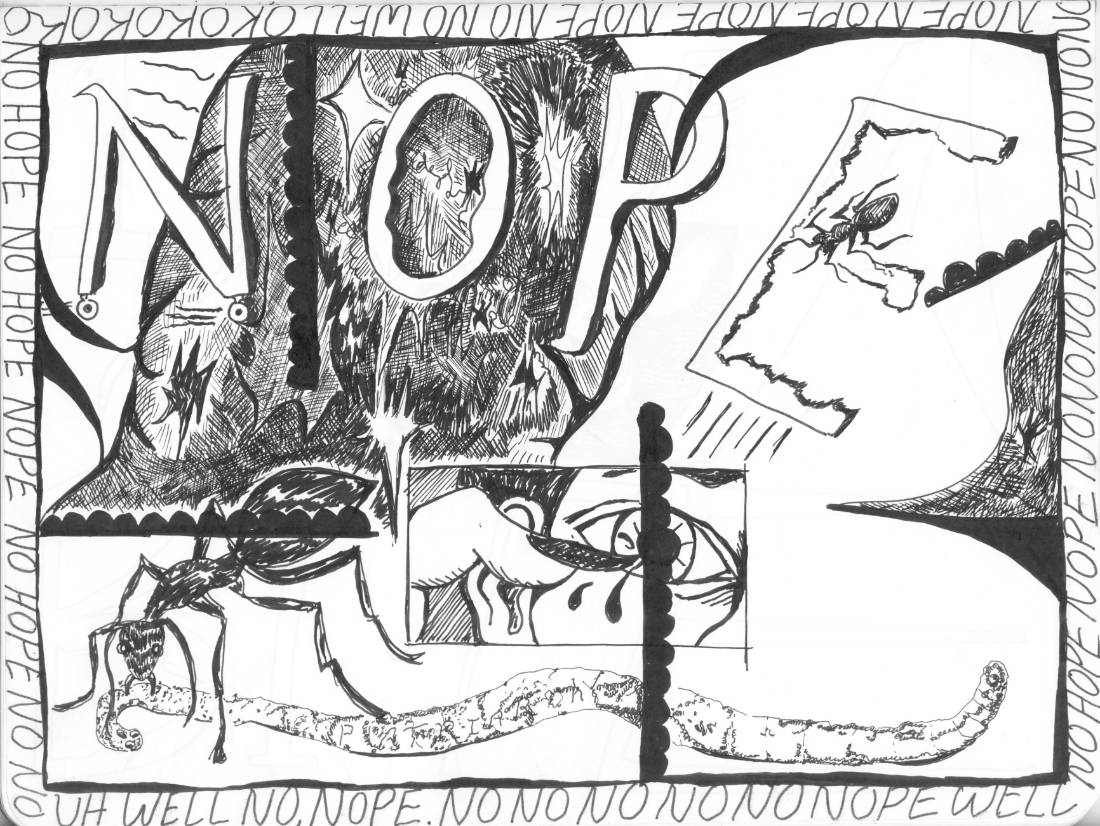
J: I use words a lot. I make comics so I use words in those, and I like to think about how text is a part of the drawing. I don't want it to just be a caption, I want it to be embedded in the image as a shape. I think Dorian has influenced me a lot in that way - writing big and letting that be the starting point of a drawing, as opposed to writing as an afterthought.
D: We both write all the time, we're big writers. But in painting and drawing there's a real emphasis on mystery. Using words and language sometimes feels like it's not allowed. It's not that you can't do it, but the conversation can revolve around being too illustrative...too direct. In painting, the mark-making and the content is supposed to do a job in the absence of words to create a mystical, spiritual experience. And I think there's a lot of pushback on writing, because it can be too on the nose. I am interested in de-constructing this belief.
J: This is what we're kind of indoctrinated with.
D: I see our collaborative drawings as an ongoing exploration of bringing writing and drawing together. I could show you a huge stack of sketchbooks of things I've never shown that feel like sets of diagrams and instructions. What Jessica and I make brings these worlds together in a way I haven't found for myself yet, but I get closer with this collaboration.
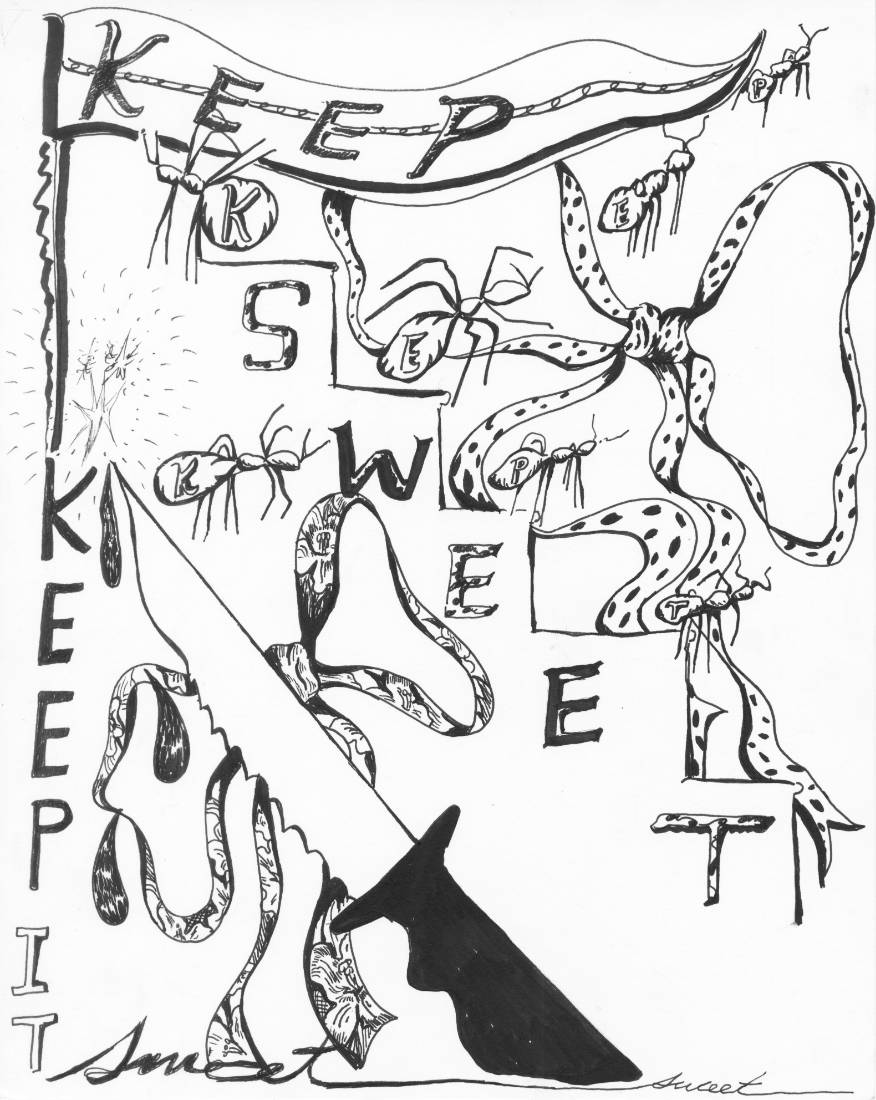
M: You also both use repeated icons, or repeated images throughout different pieces. Dorian, I know about your running hammers. Jessica, licking and spiders? Can you speak a bit about this?
D: We're often attracted to the same things. We like spiders, tennis rackets, braids, ants ... and we're both serious about funny things, and attracted to tragedy. Tragedy that's sad, but also really funny. I think that turns up in everything we make. For example, the drawing in Boxed Ether "half of a bite" was inspired by the half-submerged horse statue we drew at Dane's Dairy. What a sad situation with that horse wading in the ground for eternity. Yikes. I love how we riff off of each other with text, transforming it into decoration and a pattern. I think it's safe to say we're both interested in story-telling and funny sayings. We both mine away at catchphrases. That's how our t-shirt collaboration came about: from an angry drawing session in response to the overturning of Roe v. Wade.
J: When we do the collaborative drawings, everything we do is in response to whatever is going on that day, or what we're talking about as we're drawing. So, yes, during Roe v. Wade [being overturned], we were talking about it and drawing, like, a big fingernail poking out a man's eye or an ant eating a worm. That was also something we saw earlier that day on our walk. It's very improvisational in ways I wish my personal drawings were more like.
D: In our collaboration we lose our self-consciousness, eliminating the critical voices that usually stop us in our tracks. That's why we work together. We also just like each other's company.
J: It's interesting to see how they build off of each other. Our drawings merge into a new form that is both and neither of us, it's like we're having a baby. It's not that profound, I guess, because that's what collaboration is. And because it's just the two of us, the combining feels purer.
D: Seamless. She encourages me and I encourage her. We spend a lot of time together, and we draw. Talking or in silence. I'll pass the notebook to her, or she'll pass it to me. We don't even set a timer.
J: It's really free, when we do collaborative drawing, it feels really free.
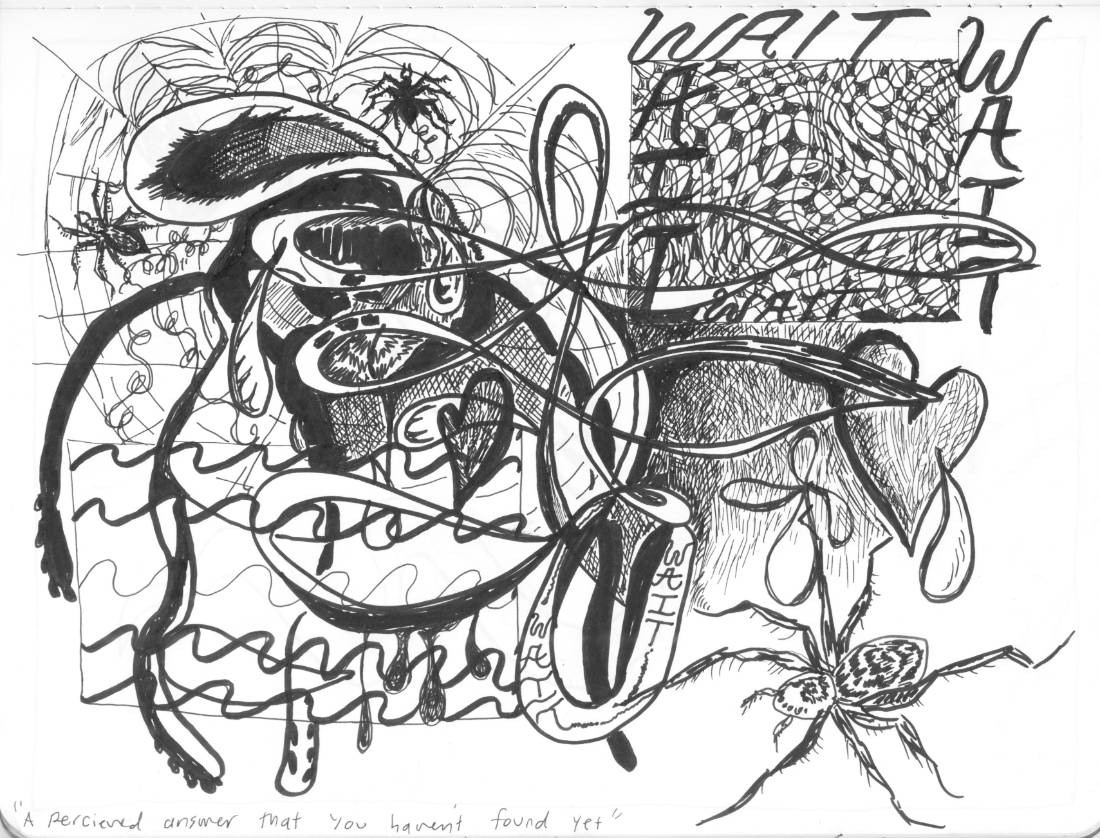

M: In any given spread in this issue of Boxed Ether - can you track who did what? Or no? How did you pick what went in? The order?
J: There are only two pages in the zine that aren't collaborative drawings. There is one page that's just me, and one page that's just Dorian. These were just the individual ones we liked the most.
D: It's one thing to say: let's do a zine, and a whole other thing to actually figure out what to include and in what order.
J: I think the order wasn't that big of a deal, which sounds weird, but because they aren't really sequential images, I felt the order was more visual - more about the spread and size. Or, there were some specifics, like the one drawing by only me, next to the one drawing by only Dorian. And the opener is one of the oldest collaborative drawings we've done, so it's more symbolic.
D: Boxed Either ... zines in general are a way to bring our drawings into a sequence that can be shared at low cost with the public. I'd say Jessica and I work together to create accountability to "finish" our work, rather than sitting in a sketchbook.
J: Yeah, I do think it's good to put things out fairly quickly sometimes without agonizing over it.
D: Without over-thinking.
J: Yeah, and maybe it doesn't have to be every month, but every couple months, maybe. That's part of my plan for Boxed Ether - to put something out regularly. To let it have the longevity that it needs. You know, I might release ten and then say fuck it, Boxed Ether is done. It will be a collection of whatever it needs to be.
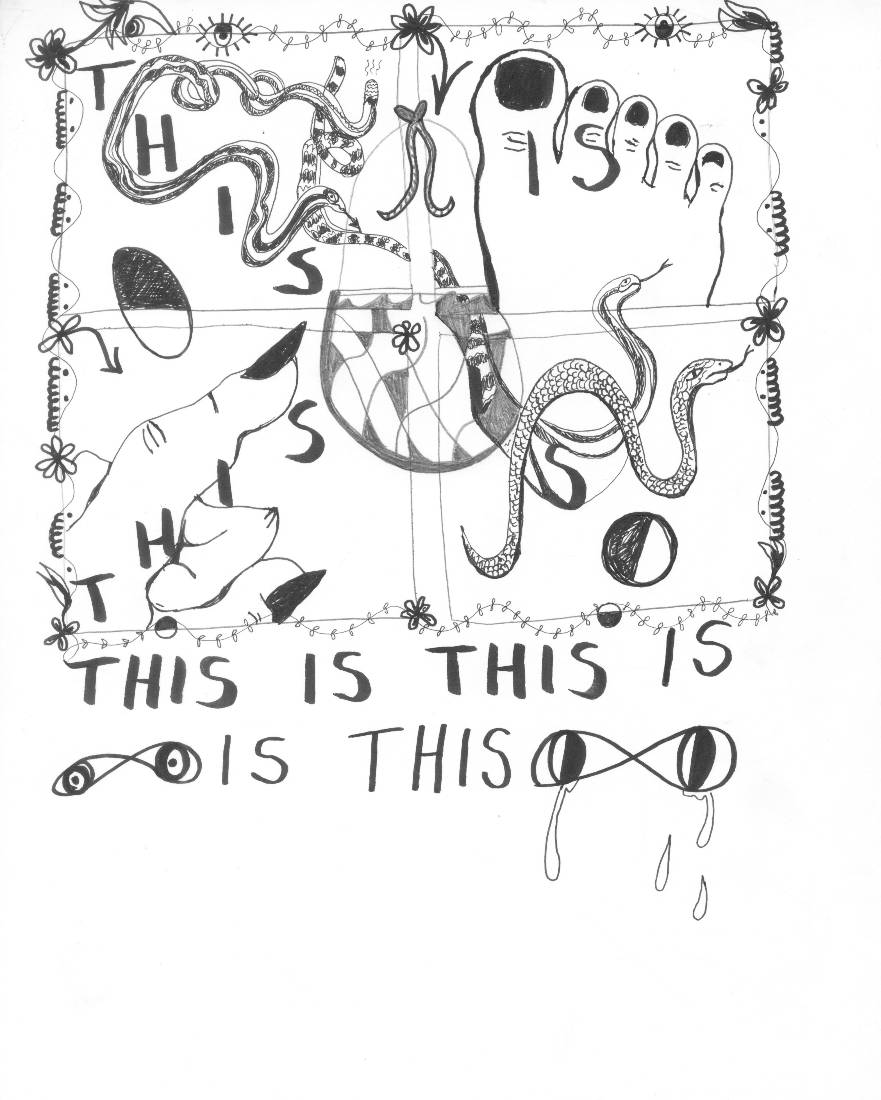
M: I’m interested in what you’re saying about quickly-put-together books, zines, whatever. I wonder where your impulse toward this comes from? Were you both interested in this before meeting, or did it come from meeting?
J: I think it's probably part of why we work so well together. I think we both have that impulse but in different ways.
D: I think we came together to get over our individual "fussiness." It's a no fuss zone when we draw.
J: We both have a deep aversion to it.
D: I took this fantastic zine survey class with Kalmia Strong and Rich Dana at the University of Iowa Library Special Collections and it really transformed my art practice. Jessica has been involved in zine making for years and years, but I had never made a zine in my life. So it opened a whole new way of making art for me. Part of our ongoing conversations is finding different modalities of sharing art or bringing to life different ideas or concepts that put the work in the world - expanding beyond the white wall gallery space.
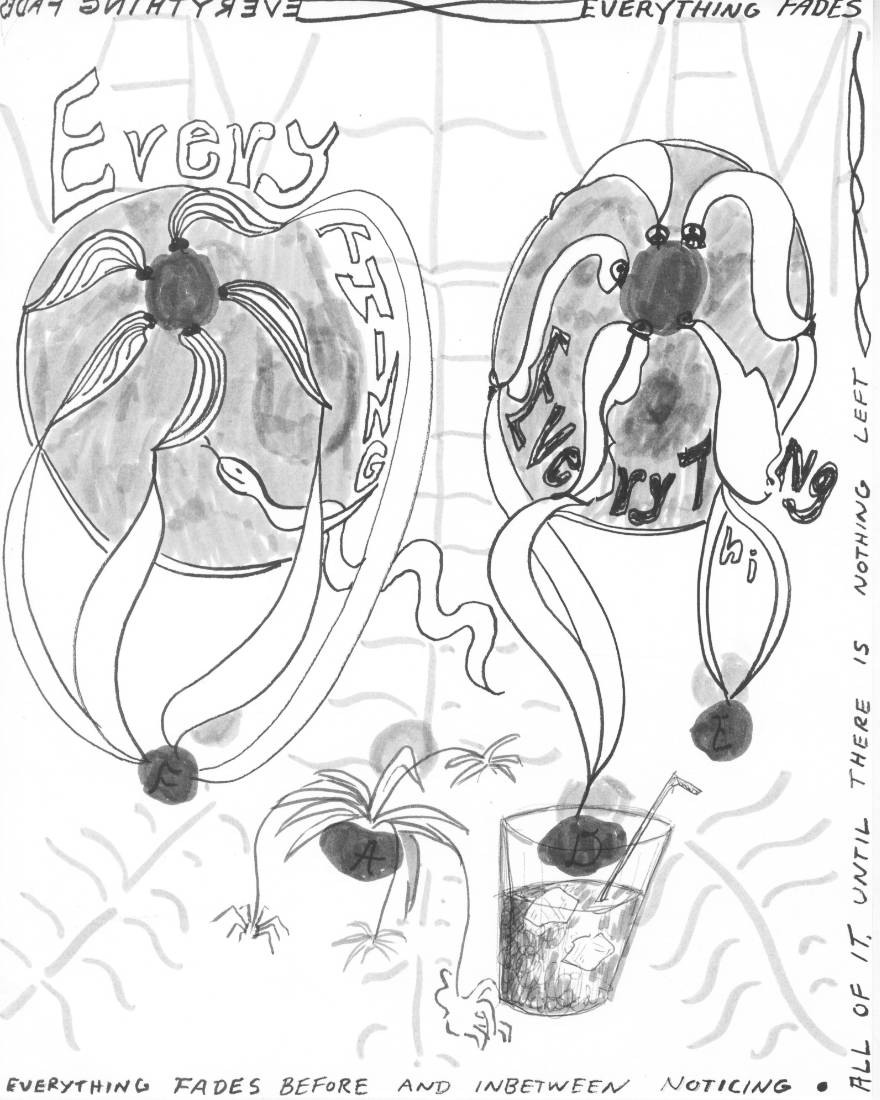
M: To finish up, will you say a bit about the physical making of this - what digital tools did you use? Where’d you print it? Why this paper, etc?
J: I edited the images in photoshop - basic brightening and stuff - to make the images print better. We made a mockup by printing out things and making a physical copy before scanning. Old-school style.
M: Everything was already this size?
J: Some of the images were originally bigger, but we printed them out at this size.
M: So you drew, scanned, printed, then scanned again?
J: Yes. You lose some of the details but there wasn't too much lost.
M: Anything else you want to say about this project, or your work together in general?
D: I think it's important to point out that this is issue #1 and it's called "You Caught Me.' Which is kind of related to the theme of spiders. But it's "you caught me" in many respects - you caught me being a lazy bone, or you caught me in a trap over-thinking ... again.
J: There tends to be lots of webs and ribbons in our drawings.
D: Being caught in the racket that is also a web.
J: We get caught up in our webs and we help each other get out.
D: Or we eat it out of the way, digest it.
J: It all comes full circle.
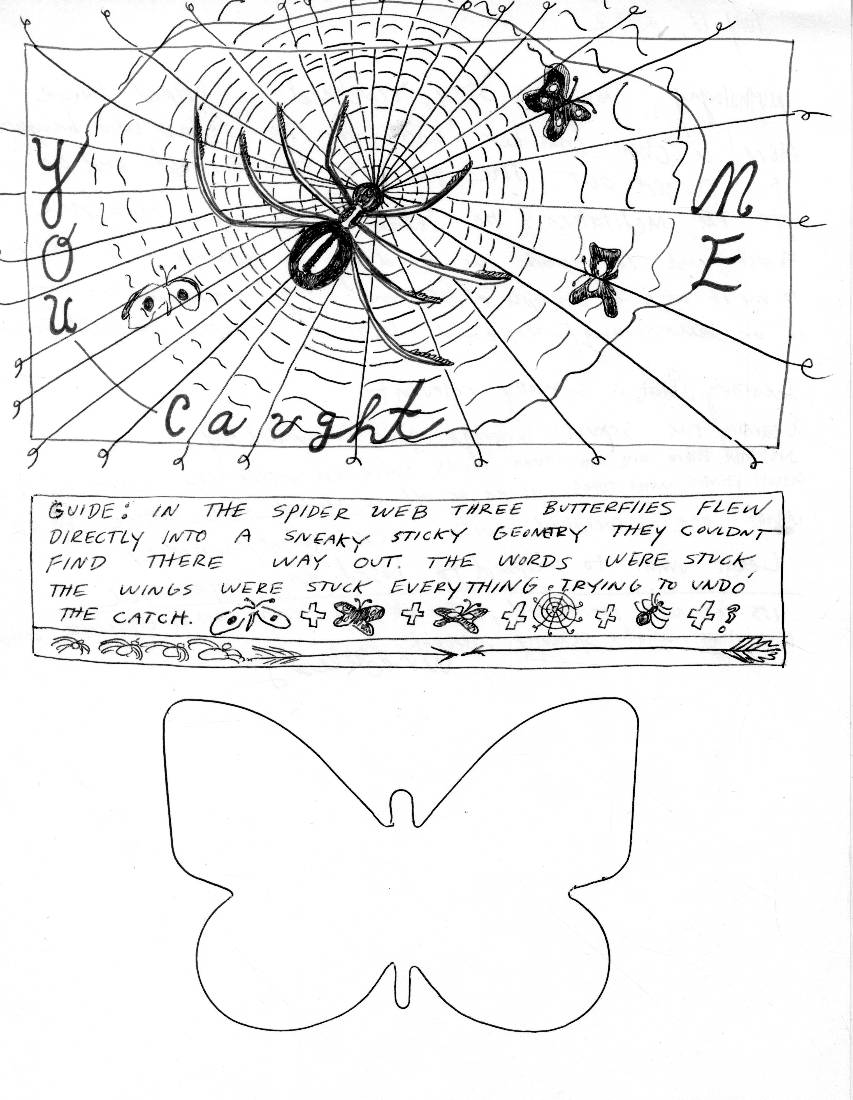
***
Dorian Dean (she/they) was born in Baltimore, Maryland and currently lives and works in Iowa City, Iowa. In 2022 Dean completed a MFA in Painting and Certificate of Book Arts at the University of Iowa and received her BFA from Tyler School of Art at Temple University. Playfulness and humor is an essential part of her practice explored through collaboration with friends and the viewers of the work. Teaching for over 15 years, Dean uses art as a tool for social change, with the belief that sharing creative experience in non-hierarchical models empowers people to get curious and question whose “rules” really serve them. As curator for the Times Club at Prairie Lights Bookstore in Iowa City, curation and collaboration has become a way to put this social change into action. Dean has taught and developed curriculums at the Baltimore Museum of Art, Philadelphia Museum of art and the Barnes Foundation. Among many afterschool programs and community arts organizations Dean taught as a teaching artist in the Claymobile, a mobile arts program working with incarcerated youth and inner-city schools in Philadelphia. Before attending the University of Iowa Dean spent five years as a kindergarten and first grade teacher at an independent cooperative school. Dorian recently exhibited at the MdW in Chicago, and created a limited risograph edition with Stop-gap projects at Mana Contemporary. Her essay and Straightforward folder series is published in the spring 2022 Currency issue of Brink an in-print literary journaldedicated to publishing hybrid, cross-genre work. Dorian's work has been shown at Charles City Arts Center, James May Gallery, Bisignano Gallery, and has two forthcoming exhibitions at University of Central Missouri and SOIL Gallery.
Jessica Dzielinski is an artist working across painting, drawing, animation, books, sound, and film. She was raised in Phoenix, Arizona and currently resides in Iowa City, Iowa where will receive an MA and MFA in Painting & Drawing and a Certificate in Book Arts from the University of Iowa in 2023. She is the publisher of Boxed Ether, an ongoing art zine featuring personal and collaborative works.
Margaret Yapp is from Iowa City. She works as the Image + Word editor at Prompt Press. Margaret is currently an MFA candidate at the University of Iowa Center for the Book and a member of the Iowa City Poetry Advisory Council. She has an MFA in poetry from the Iowa Writers' Workshop. Her work has appeared in Tupelo Quarterly, Second Factory, Asphalte, and elsewhere. You can read more at Margaret’s website which is margaret yapp dot com.